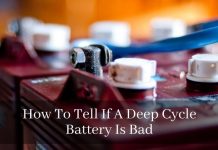
Imagine how life would sound like without television sets. It would feel boring based on the fact you won’t have somewhere to catch up with your favorite movie series. In the recent past, TVs are becoming more and more portable.
You can now have television sets everywhere, like in your travel trailer, for example. You have probably seen big screens fixed in those vehicles, and you’re left wondering where they source their power. Like it’s with a refrigerator, the TVs in this setting get their power from a battery.
So, how long can a deep cycle battery run a TV? There is never a straight answer to this query because the run-time is dependent on the size of the cell, as well as the TV’s power requirement.
Say, for instance, a 100 amp-hour AGM deep cycle battery can power your 150-watt TV for about six hours. A 50-watt battery can run on the same battery for 20 hours. There are also small TVs (20-watt), which can empty the same cell within 56 hours.
All the figures are rough estimates based on the fact that your battery may not be full. Besides, the connection also determines the run-time. For example, if your connection doesn’t include any inverter at all, it means that the TV will run for a more extended time.
According to battery specialists, a direct connection will add 15% more run time on the same battery.
How Many Watts Does Your TV Use?
When buying a TV, you may have noticed something (number of watts) written on the TV’s casing. If you’re lucky enough to own several sets in different sizes, you may have realized that the figures are different. It rises as the size of the screen increases.
For instance, say the smallest TVs (15” – 20”). These sets tend to consume about 15-26 watts. The medium category (21” – 32”) runs on about 26-70 watts. Then there is the broader category, which includes sets between 32”-55”. The TVs in the category use about 55-150 watts.
When shopping for a new TV set, you will learn that there are some which are categorized as LED while others are LCD. You should take note of these features as they play a significant role when it comes to TV consumption.
Even with the same size, an LED TV is likely to consume less energy as opposed to the LCD ones. They are said to use ⅔ less power as compared to the popular LCD screens.
Today, new and slim television sets keep hitting the market. But, that doesn’t mean that history is to be forgotten. You can’t ignore the old CRT TVs which were the talk of the town, years ago.
The old-school sets weren’t energy efficient as they use 65-120 watts. Recently, there is also the Plasma TVs, which are a bit extra when it comes to consumption. These models use between 150-300 watts, and that’s based on the size.
How Many Amp Hours Does Your Deep Cycle Battery Have?
You shouldn’t get confused whenever the term deep cycle battery is mentioned. Deep cycle batteries are types of cells designed for long-term supply of steady charge. It’s for this reason that these battery models are recommended for heavy trucks or machinery. They are designed with thicker lead plates, and less surface area and that allow slower and hence longer discharge period.
Currently, you can find various sizes of deep-cycle cells. For instance, you may find those rated 100, 90, 80, 65, and 55 amp-hour ratings. It’s these ratings that give an idea about the battery’s capacity.
Say an 80 AH deep cycle battery, for example. This battery should be able to deliver one amp per hour for 80 hours. Or, the battery can give two amps per hour for 40 hours. Therefore, the higher the drain or power requirement, the lower the AH rating.
What Kind of Inverter Does Your RV Need?
Television sets are designed for use at home, and while connected to an electricity supply. But, what will happen is there is a blackout? Or, what if you want to have a TV installed in your RV, for example?
It’s at this point that you introduce a battery to help with the situation. Unfortunately, a battery gives direct current while a TV runs on alternating current.
For a TV set to run on the battery, you will need an inverter. An inverter is an electrical device that helps convert the DC from the battery into AC that your tv requires to function.
When picking an inverter, it’s recommended that you go for a size that matches your power needs. For example, an inverter with 800 peaks watts can accommodate your TV set along with other accessories such as the DVD player and game console.
When shopping for an inverter, you will realize that there are those which are pure and the modified ones. The modified ones, especially, are the most commonly used as they come with a lower price tag. However, they are not considered to be the safest option.
Therefore, if you’re planning to run delicate electronics using a battery, it would be best if you went for a pure sine wave inverter. Often, the modified inverters have resulted in damages on the sophisticated electronics during power outages.
As stated earlier, about 15% of the energy is lost while using an inverter. From an expert’s perspective, the power is lost while converting the direct current (DC) from the battery to the alternating current (AC) that your electronics require to function normally.
Conclusion
Running your TV set on a battery is very much possible. Each TV requires a certain amount of power to perform. This energy can be provided by the battery, with the help of an inverter.
As explained in the article, the amount of energy drawn from the battery is dependent on the size and model of your television. Read through the entire article to know the size of the battery you require to run your tv.





